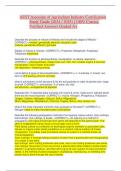AEST Associate of Agriculture Industry Certification
Study Guide () | 100% Correct
Verified Answers Graded A+
Describe the process of mitosis & Meiosis and include the stages of Mitosis -
CORRECT>>mitosis- genetically identical; daughter cells.
meiosis- genetically different; gamates
Stages of mitosis & meiosis -CORRECT>> Prophase, Metaphase, Anaphase,
Telophase,Interphase
Describe the function of photosynthesis, transpiration, & cellular respiration. -
CORRECT>>photosynthesis- makes food, sun, h20, co2, creates sugars & starches
transpiration- loss of water from plant
cell respiration- releasing energy
List & define 8 types of land classification -CORRECT>> 1-4 cultivate (1 is best, can
farm on)5-8 grazing (only for animals)
what is soil texture vs soil structure & list the soil particles in order of particle size- large
to small -CORRECT>> soil texture- % of sand, silt, clay
soil structure - arrangement of particles
Separate the 17 essential plant nutrients into macro & micro, make sure t indicate which
three are the most important -CORRECT>> macro: Nitrogen, Phosphorus, Potassium,
Oxygen, Carbon, Hydrogen, Calcium, Sulfur, Magnesium.
Micro: Maganese, Molybdenum, Chlorine, Copper, Boron, Zink, Nickel, Iron
what is the most important nutrient's main purpose for the plant? -CORRECT>>
Nitrogen;helps to make the plant green (chlorophyll)
Describe the following propagation methods of air layering, tissue culture, stem cuttings,
leaf cuttings, root cuttings, & seeds. -CORRECT>> Air layering is a method of
propagating new trees and shrubs from stems still attached to the parent plant. The
stem is wrappedwith damp moss to encourage roots to form.
Plant tissue culture is a collection of techniques used to maintain or grow plant cells,
tissues or organs under sterile conditions on a nutrient culture medium of known
composition. It is widely used to produce clones of a plant in a method known as
micropropagation.
Stem cuttings: It involves taking a section of stem from a parent plant and manipulating
it to create a new plant.
leaf cuttings: stem cutting produces new roots, and a root cutting produces new stems
root cuttings: the portion of root is cut from a parent plant (often called a mother plant),
placed in a growing medium, and then left to grow its own system of roots and stems.
seeds: is the method of plant propagation (multiplying, reproducing, or breeding new
plants) that is done through the use of seeds.
, What is germination vs propagation -CORRECT>> germination- seed
sproutspropagation- growing plants
Describe asexual plant propagation & sexual plant propagation. -CORRECT>>
asexual:cuttings, layering, division, buddings, & grafting
sexual:involves the union of the pollen (male) with the egg (female) to produce a seed
Breakdown the spermatophyta category of plants & describe each sub level. -
CORRECT>>Gymnosperm- cones, naked seeds
Angiosperm- Flower parts (monocotyledons- first leaf, parallel veins, non-woody flowers
* 3) (dicotyledons- netted veins, woody, flowers *4 or 5).
describe the vascular system of a monocotyledon & dicotyledon -CORRECT>>
monocot-vascular bundles
dicot- organized
What are the 3 vegetative parts of the plant & what are their main function? -
CORRECT>>leaf- photosynthesis
stem-support
root- water/ nutrients
what are the two types of roots? -CORRECT>> tap & fibrous
list & describe 5 modified stems -CORRECT>> Tuber: eyes, food storage,
propagation(growing plants), underground
Rhizome(turf grass, ginger): underground horizontal stem, food storage
bulb: with bulblets, underground, food storage
bulb with leaves: underground, food storage
cladophyl: stem that goes through photosynthesis, above ground
stolon( golf course grass): above ground, horizontal stem, photosynthesis
what is the reproductive part of the plant? -CORRECT>> The flower is the reproductive
unit of some plants (angiosperms). Parts of the flower include petals, sepals, one or
more carpels (the female reproductive organs), and stamens (the male reproductive
organs).
What is osmosis? -CORRECT>> is the passive transport of water across a selectively
permeable membrane in order to reduce a concentration difference of a solute between
a concentrate and permeate solution separated by the membrane
Name the cereal crops -CORRECT>> Rice 2. Wheat, bread wheat 3. Durum wheat,
macaroniwheat 4. Corn or maize 5. Job's Tears, salay, adlay, tigbe, pawas 6. Barley 7.
Millet 8.
Sorghum 9. Oat 10. Rye 11. Triticale 12. Teff, taf 13. Fonio 14. Wild rice, Canada rice,
Indian rice, water oats 15. Spelt 16. Canary grass




